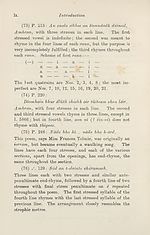Download files
Complete book:
Individual page:
Thumbnail gallery: Grid view | List view

Introduction
lix.
(69) P. Ill:
’Bfhedrr learn breacan uadlach mu’m ghuodllibh ’s a
chtir fo m’ dchlais.
Each long line has four stresses. The third and fourth
stressed syllables assonate, and final a-rhyme is main¬
tained throughout. In 3015, ghloic must be pronounced
glaoic (as in fact it is now) to rhyme with saighdeir. In
3039, coireadh rhymes with coill’ thu.
(70) P. 125 : Tha mulad tha gruaim orm tha bron.
The first, second and last lines of each stanza have three
stresses and the same end-rhyme, with ultimate final
stress. The two short lines may be regarded as one long
line with four stresses, and with assonance between the
second and fourth stressed syllables, the final stress being
penultimate, and the final stressed syllable rhyming with
the second stressed syllable of the last line. Cf. the
third line of John MacCodrum’s poem, p. 68.
(71) P. 149:
’Si so ’n iimsir a dho&rbhar an tkvrgneachd dhuinn.
Each long line has four stresses. The second and third
stressed syllables assonate; in the last line always, and
in the other lines often, the first, second and third
stressed syllables assonate. The final stressed syllables
rhyme throughout the stanza. Scheme of first rann:—•
(—) — a a — a — — u
— a a a u
— e e e u
— — eirg airg eirbh u
(72) P. 155:
Air teachd o’n Spain do shliochd an Ghdoidhil
ghldis.
The heroic rhymed couplet of Pope and Dry den.
lix.
(69) P. Ill:
’Bfhedrr learn breacan uadlach mu’m ghuodllibh ’s a
chtir fo m’ dchlais.
Each long line has four stresses. The third and fourth
stressed syllables assonate, and final a-rhyme is main¬
tained throughout. In 3015, ghloic must be pronounced
glaoic (as in fact it is now) to rhyme with saighdeir. In
3039, coireadh rhymes with coill’ thu.
(70) P. 125 : Tha mulad tha gruaim orm tha bron.
The first, second and last lines of each stanza have three
stresses and the same end-rhyme, with ultimate final
stress. The two short lines may be regarded as one long
line with four stresses, and with assonance between the
second and fourth stressed syllables, the final stress being
penultimate, and the final stressed syllable rhyming with
the second stressed syllable of the last line. Cf. the
third line of John MacCodrum’s poem, p. 68.
(71) P. 149:
’Si so ’n iimsir a dho&rbhar an tkvrgneachd dhuinn.
Each long line has four stresses. The second and third
stressed syllables assonate; in the last line always, and
in the other lines often, the first, second and third
stressed syllables assonate. The final stressed syllables
rhyme throughout the stanza. Scheme of first rann:—•
(—) — a a — a — — u
— a a a u
— e e e u
— — eirg airg eirbh u
(72) P. 155:
Air teachd o’n Spain do shliochd an Ghdoidhil
ghldis.
The heroic rhymed couplet of Pope and Dry den.
Set display mode to:
![]() Universal Viewer |
Universal Viewer | ![]() Mirador |
Large image | Transcription
Mirador |
Large image | Transcription
| An Comunn Gàidhealach > An Comunn Gàidhealach Publications > Bàrdachd Ghàidhlig > (63) |
|---|
| Permanent URL | https://digital.nls.uk/126455774 |
|---|
| Description | This contains items published by An Comunn, which are not specifically Mòd-related. It includes journals, annual reports and corporate documents, policy statements, educational resources and published plays and literature. It is arranged alphabetically by title. |
|---|
| Description | A collection of over 400 items published by An Comunn Gàidhealach, the organisation which promotes Gaelic language and culture and organises the Royal National Mòd. Dating from 1891 up to the present day, the collection includes journals and newspapers, annual reports, educational materials, national Mòd programmes, published Mòd literature and music. |
|---|---|
| Additional NLS resources: |
|

